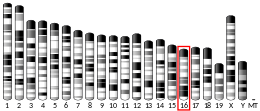TBX1
T-box transcription factor TBX1 also known as T-box protein 1 and testis-specific T-box protein is a protein that in humans is encoded by the TBX1 gene.[5] Genes in the T-box family are transcription factors that play important roles in the formation of tissues and organs during embryonic development.[6] To carry out these roles, proteins made by this gene family bind to specific areas of DNA called T-box binding element (TBE)[6] to control the expression of target genes.
Gene
The TBX1 gene is located on the long (q) arm of chromosome 22 at position 11.21, from base pair 18,118,779 to base pair 18,145,669.[5]
Function
The T-box 1 protein appears to be necessary for the normal development of large arteries that carry blood out of the heart, muscles and bones of the face and neck, and glands such as the thymus and parathyroid.[7][8] Although the T-box 1 protein acts as a transcription factor, it is not yet known which genes are regulated by the protein.
Clinical significance
Most cases of 22q11.2 deletion syndrome are caused by the deletion of a small piece of chromosome 22. This region of the chromosome contains about 30 genes, including the TBX1 gene. In a small number of affected individuals without a chromosome 22 deletion, mutations in the TBX1 gene are thought to be responsible for the characteristic signs and symptoms of the syndrome. Of the three known mutations, two mutations change one amino acid (a building block of proteins) in the T-box 1 protein. The third mutation deletes a single amino acid from the protein. These mutations likely disrupt the ability of the T-box 1 protein to bind to DNA and regulate the activity of other genes.[9][10][11]
Loss of the TBX1 gene, due to either a mutation in the gene or a deletion of part of chromosome 22, is responsible for many of the features of 22q11.2 deletion syndrome. Specifically, a loss of the TBX1 gene is associated with heart defects, an opening in the roof of the mouth (a cleft palate), distinctive facial features, and low calcium levels, but does not appear to cause learning disabilities.[12][13]
References
- GRCh38: Ensembl release 89: ENSG00000184058 - Ensembl, May 2017
- GRCm38: Ensembl release 89: ENSMUSG00000009097 - Ensembl, May 2017
- "Human PubMed Reference:". National Center for Biotechnology Information, U.S. National Library of Medicine.
- "Mouse PubMed Reference:". National Center for Biotechnology Information, U.S. National Library of Medicine.
- "Entrez Gene: T-box 1".
- Bollag RJ, Siegfried Z, Cebra-Thomas JA, Garvey N, Davison EM, Silver LM (July 1994). "An ancient family of embryonically expressed mouse genes sharing a conserved protein motif with the T locus". Nature Genetics. 7 (3): 383–9. doi:10.1038/ng0794-383. PMID 7920656.
- Jerome LA, Papaioannou VE (March 2001). "DiGeorge syndrome phenotype in mice mutant for the T-box gene, Tbx1". Nature Genetics. 27 (3): 286–91. doi:10.1038/85845. PMID 11242110.
- Lindsay EA, Vitelli F, Su H, Morishima M, Huynh T, Pramparo T, Jurecic V, Ogunrinu G, Sutherland HF, Scambler PJ, Bradley A, Baldini A (March 2001). "Tbx1 haploinsufficieny in the DiGeorge syndrome region causes aortic arch defects in mice". Nature. 410 (6824): 97–101. doi:10.1038/35065105. PMID 11242049.
- Baldini A (October 2003). "DiGeorge's syndrome: a gene at last". Lancet. 362 (9393): 1342–3. doi:10.1016/S0140-6736(03)14671-5. PMID 14585631.
- Baldini A (May 2004). "DiGeorge syndrome: an update". Current Opinion in Cardiology. 19 (3): 201–4. doi:10.1097/00001573-200405000-00002. PMID 15096950.
- Yagi H, Furutani Y, Hamada H, Sasaki T, Asakawa S, Minoshima S, Ichida F, Joo K, Kimura M, Imamura S, Kamatani N, Momma K, Takao A, Nakazawa M, Shimizu N, Matsuoka R (October 2003). "Role of TBX1 in human del22q11.2 syndrome". Lancet. 362 (9393): 1366–73. doi:10.1016/S0140-6736(03)14632-6. PMID 14585638.
- Packham EA, Brook JD (April 2003). "T-box genes in human disorders". Human Molecular Genetics. 12. 12 Spec No 1 (Spec No 1): R37-44. doi:10.1093/hmg/ddg077. PMID 12668595.
- Yamagishi H, Srivastava D (September 2003). "Unraveling the genetic and developmental mysteries of 22q11 deletion syndrome". Trends in Molecular Medicine. 9 (9): 383–9. doi:10.1016/S1471-4914(03)00141-2. PMID 13129704.
Further reading
- Tan X, Anzick SL, Khan SG, Ueda T, Stone G, Digiovanna JJ, Tamura D, Wattendorf D, Busch D, Brewer CC, Zalewski C, Butman JA, Griffith AJ, Meltzer PS, Kraemer KH (September 2013). "Chimeric negative regulation of p14ARF and TBX1 by a t(9;22) translocation associated with melanoma, deafness, and DNA repair deficiency". Human Mutation. 34 (9): 1250–9. doi:10.1002/humu.22354. PMC 3746749. PMID 23661601.
External links
- TBX1+protein,+human at the US National Library of Medicine Medical Subject Headings (MeSH)
- Online Mendelian Inheritance in Man (OMIM): 602054
- EntrezGene 6899
- GeneCard for TBX1
This article incorporates text from the United States National Library of Medicine, which is in the public domain.



